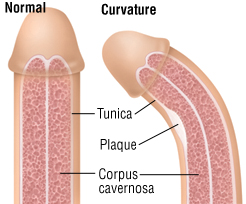Crooked Penis – Onset of Peyronie’s Disease
A Curved Penis Isn’t Normal
It’s Usually the First Leg of an Ugly Path
Let Us Fix it For You Now
A crooked penis is becoming so common among young guys that many are starting to think its just normal. Morganstern Medical has a proprietary protocol that works to resolve the curvature.
It’s not.
We now can accurately identify such curvature as “Pre-Peyronie’s” – sense such curvature often deteriorates into full-fledged Peyronie’s Disease.
Why’s that?
Two Big Reason’s Peyronie’s Disease Occurs
Most experts agree Peyronie’s disease is likely the consequence of a minor penile trauma. The most common source of this type of penile trauma is thought to be vigorous sexual activity (e.g., repeated masturbation, vigorous penetration during intercourse, pressure from a partner’s pubic bone, etc.). This minor starting injury Injury triggers a cascade of inflammatory and cellular events resulting in a process called fibrosis – where the body sends fibrous tissue in an effort to protect and heal the traumatized tissue. If such trauma continues? The body keeps trying to “repair” the problem – triggering more fibrosis reactions – an often an eventual build up of hardened fibrous tissue under the skin of the penis. Such fibrous plaque is only noticeable when erection occurs – as it causes a noticeable new curvature in a man’s penis when he’s completely hard.
 The “scar tissue” you’ll often hear associated with Peyronie’s Disease is what forms after the now bent penis incurs an event of more intense trauma – often from intercourse. The combination of being hardened with internally brittle plaque and naturally curved beyond the norm creates a basis for the inevitable “accident” – when the penis bends hardly during sex and the plaque “cracks”. What follows is scar tissue the body forms in an effort to heal the situation. This newly formed scar tissue creates a crux for potentially extreme curvature: and full-fledged Peyronie’s Disease is born.
The “scar tissue” you’ll often hear associated with Peyronie’s Disease is what forms after the now bent penis incurs an event of more intense trauma – often from intercourse. The combination of being hardened with internally brittle plaque and naturally curved beyond the norm creates a basis for the inevitable “accident” – when the penis bends hardly during sex and the plaque “cracks”. What follows is scar tissue the body forms in an effort to heal the situation. This newly formed scar tissue creates a crux for potentially extreme curvature: and full-fledged Peyronie’s Disease is born.
The disease is usually divided into two distinct stages. The first phase is the acute phase; this portion of the disease persists for six to 18 months and is usually characterized by pain, worsening penile curvature and formation of penile plaques. The second phase is the chronic phase, during which the plaque and penile curvature are stable but problems with calcification and erectile dysfunction may occur.
Other Issues Can Hasten Peyronie’s Disease
Penile injury isn’t the only primary driver of Peyronie’s. Peyronie’s indications are born from the build up of fibrous or calcified plaque in the penis. This plaque can occur from a variety of sources, including:
- Genetic Predisposition: some men are prone to having excessive plaque in their bloodstream and given the fact a penis requires lots of blood flow to function normally? That plaque builds up.
- Certain Health Conditions: such as diabetes, tobacco use, or a history of pelvic trauma (from sports or accidents) can also lead to abnormal wound healing and may contribute to the development of Peyronie’s disease.
- Diseases: can also be a cause for penis curvature. Some diseases can cause the breakdown of normal tissue in the penis. Diabetes for example breaks down collagen, which in turn causes hardening in the penis.
Peyronie’s Disease and Penile Shortening
Peyronie’s Disease Causes Penile Shortening
We Can Fix That!
Penile Shortening
Penile Shortening caused by Penile Fibrosis can be damaging to the overall health of the penis. Penile Fibrosis is the hardening of tissue within the penis that is a direct cause of Peyronie’s Disease. Most of the time the shortening of the penis will be seen in the erect state. Plaque develops in the penis as a direct effect of Penile Fibrosis. Surgical procedures to correct Peyronie’s disease also can result in a loss of penile length.
Don’t Wait to Get Treated
An earlier, old-school approach to Peyronie’s Disease was to “wait” and see if the condition improves. We’ve since learned this approach is a capital mistake. Peyronies is a degenerative disease: it only gets worse with time. Also, you can cause additional scar tissue because of the irregular curve during intercourse making matters worse.
What is Peyronie’s Disease?
Peyronie’s disease is when your penis is bent at more than a 30 degree angle. Penile curvature is a condition caused by Peyronie’s disease. Just through direct observation you will be able to tell if you have a problem with penile curvature.
Symptoms of Peyronie’s Disease
Pain and curvature are the two most obvious symptoms when it comes to Peyronie’s Disease. Pain will be felt upon erection and can actually be inflicted on your sexual partner through intercourse. Once erect you will notice the penile curvature. When you see the curve you should perform a physical inspection to see if there is any hardening, nodules or indentions along the sides of your penis. Another symptom of Peyronie’s Disease is penile shortening. This is usually caused by Penile Fibrosis.
